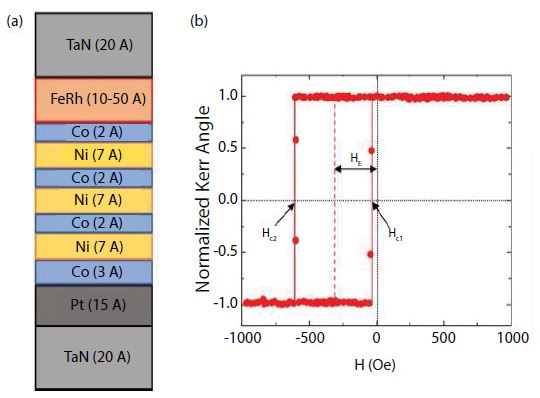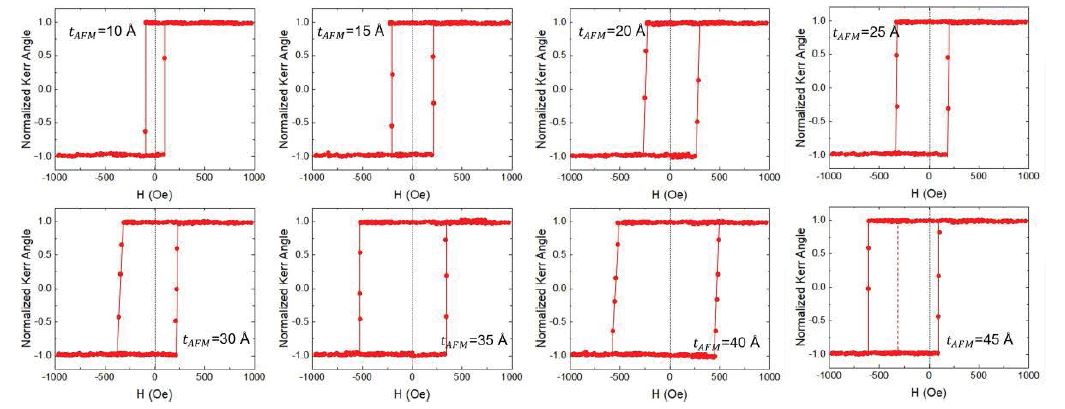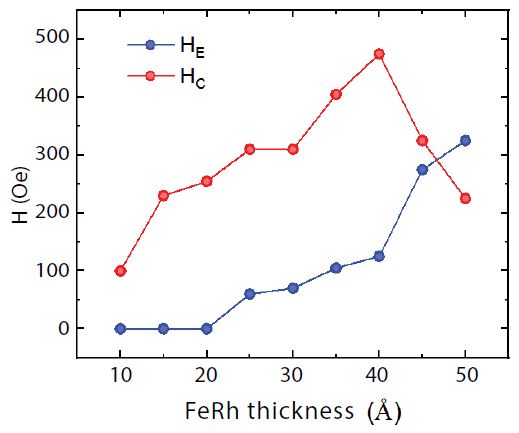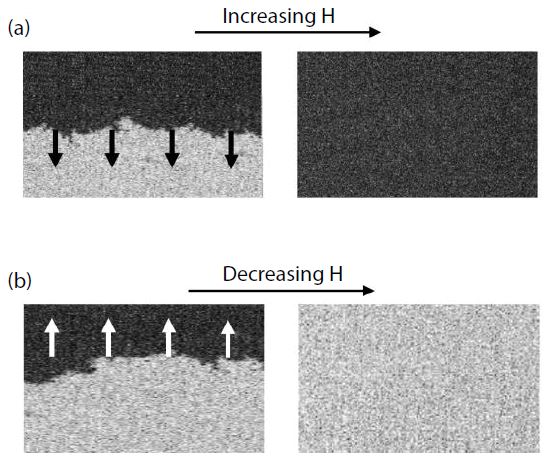Journal Name: Journal of Multidisciplinary Research and Reviews
Article Type: Research
Received date: 27 August, 2019
Accepted date: 06 September, 2019
Published date: 13 September, 2019
Citation: Jekal S, Phuong D (2019) TPerpendicular Exchange Bias of Co/Ni Multilayers Adjacent to Antiferromagnetic FeRh Layer. J Multidis Res Rev Vol: 1, Issu: 2 (13-22).
Copyright: © 2019 Jekal S. This is an open-access article distributed under the terms of the Creative Commons Attribution License, which permits unrestricted use, distribution, and reproduction in any medium, provided the original author and source are credited.
Abstract
The perpendicular exchange bias effect is observed in the ferromagnetic Co/Ni multilayers adjacent to the antiferromagnetic FeRh layer. It is found that as the antiferromagnetic FeRh thickness increases from 10 Å to 50 Å, the hysteresis loop is gradually changed from the symmetric shape to the asymmetric shape shifted by some amount corresponding to the exchange-biased field at the thickness of 25 Å. Also, the magnetic domain observation experiment confirms that the domain reversals in the increasing and the decreasing field regions of the sample with the thickness of 50 Å exhibit the same single domain wall motion even though they have the different coercivities.
Keywords
Exchange bias effect, Perpendicular exchange bias
Abstract
The perpendicular exchange bias effect is observed in the ferromagnetic Co/Ni multilayers adjacent to the antiferromagnetic FeRh layer. It is found that as the antiferromagnetic FeRh thickness increases from 10 Å to 50 Å, the hysteresis loop is gradually changed from the symmetric shape to the asymmetric shape shifted by some amount corresponding to the exchange-biased field at the thickness of 25 Å. Also, the magnetic domain observation experiment confirms that the domain reversals in the increasing and the decreasing field regions of the sample with the thickness of 50 Å exhibit the same single domain wall motion even though they have the different coercivities.
Keywords
Exchange bias effect, Perpendicular exchange bias
Introduction
In general, when the ferromagnetic (FM) film is adjacent to the antiferromagnetic (AFM) layer, the magnetic hysteresis loop of the film exhibits an asymmetric shape moved to a particular direction of magnetic field due to the interaction at the interface [1]. Such phenomena in the AFM/FM film is called as an exchange bias effect. In addition, the magnetic hysteresis loop shifted to a certain direction is used to measure the degree of the exchange bias effect. While the exchange bias effect is classified as an in-plane exchange bias and a perpendicular exchange bias depending on the magnetic anisotropy direction of the FM film, most studies have been done in the in-plane exchange bias so far [2-8]. However, since the perpendicular exchange bias is recently discovered, new phenomenon in the promising exchange bias have attracted new attention due to the possibility of application to spintronics devices such as magnetic sensors, magnetic recording read heads and magnetic random access memory (MRAM) [9-15].
In most FM/AFM structures with perpendicular exchange bias effect, Co/Pd [16-18] and Co/Pt [9-11,15] mulilayers have being mainly used for the FM material due to their strong perpendicular magnetic anisotropy, while FeRh [19-21], FeMn [11,22], IrMn [9,15,23,24], and FeCl2 [25] are considered as the AFM material. Furthermore, since the asymmetric inversion on magnetization is observed in the perpendicular exchange bias, the magnetic domain movement also have been actively studied to a broaden understanding of the exchange bias [13,26,27]. In particular, the change of the exchange bias magnetic field HE and the coercivity HC is known as the results of the complex interaction of AFM/FM domain wall as well as an unidirectional anisotropy coming from the AFM/FM interface [1,2,28,29].
In this paper, we confirmed the perpendicular exchange bias effect experimentally in a thin film composed of FM Co/Ni multilayer and AFM FeRh layer. In recent years, Co/Ni multilayer is being used for the current-induced spin dynamics due to its relatively small HC and fast domain wall mobility compared to Co/ Pd and Co/Pt multilayers [30-39]. In order to investigate the thickness of AFM layer dependent exchange bias effect, we produced samples with various thickness (from 10 Å to 50 Å) of FeRh which is G-type AFM material. G-type AFM material is a promising candidate to tailor the interface spin configuration for exchange bias. In G-type AFM materials, the nearest neighboring magnetic moments on the (001) plane align antiferromagnetically whereas those on the (111) plane have a ferromagnetically ordered spin configuration, providing the ideal uncompensated interface for exchange bias [40]. The magnetic hysteresis loops were measured by using a home-built longitudinal magneto-optical Kerr effect (MOKE) set-up based on photoelastic modulation. In addition, the magnetic domain revolution patterns in regions with both increasing and decreasing magnetic field were observed by using a magneto-optical microscope.
Figure 1:(a) Schematic diagram of the detailed sample structure basically consisting of the FM Co/Ni multilayer and the AFM FeRh layer. (b) Kerr hysteresis loop of the sample with the FeRh thickness of 50 Å exhibiting the exchange bias effect. Here, HC1 and HC2 correspond to the coercivities in the increasing and the decreasing field regions, respectively. HE denotes the exchange-biased field.
Materials and Methods
The samples were deposited on the Si(100) substrate by using a dc magnetron sputtering system under working pressure of 1.4 × 10−6 Torr. The Si(100) substrates were loaded for deposition without removing the amorphous SiO2, and the targets were pre-sputtered for 20 minute before deposition. A dc-magnetic field of 1.5 kOe was applied parallel to the substrate surface during the growth of the film to set the exchange bias direction in the films. All the layers were deposited at room temperature.
During magnetic annealing was carried out in a vacuum chamber in 5 × 106 Torr at 400°C for 1 hour, the annealing temperature was controlled using a proportional-integralderivative (PID) controller.
The detailed structure of sample is illustrated in Figure 1(a). In the exchange bias, Co/Ni multilayer with Pt contributes to the perpendicular magnetic anisotropy, while FeRh serves as AFM material. TaN deposited above and below the layer was used for the capping layer.
The measurements of the magnetic hysteresis loops were carried out using a home-built longitudinal MOKE. A solenoid was used to generate the magnetic field in steps of 0.3 Oe by sweeping the current using a programmable constant current source. The thickness of the individual layers was determined using specular X-ray reflectivity measurements carried out using X-pert Panalytical X-ray diffractometer. In addition, the magnetic domain revolution patterns under the increasing and the decreasing magnetic field were observed by using a magneto-optical microscope. The obtained image was converted to an artificial image with better contrast through a real-time image processing system.
Results and Discussion
Using a longitudinal MOKE, we measured the magnetic hysteresis loop of the FM Co/Ni multilayer adjacent to the AFM FeRh layer of various thicknesses. Figure 1(b) shows a magnetic hysteresis loop of a sample having a FeRh thickness tAFM = 50 Å. The Kerr angle corresponding to the magneto-optical intensity is almost proportional to the magnetization M of the magnetic material. Therefore, we present normalized Kerr angle (θ/θS) which corresponds to saturated magnetization (MS) with angle of Kerr θ for convenience. Unlike a typical ferromagnetic thin film which shows a symmetrically shaped magnetic hysteresis loop, it exhibits an asymmetric shape moved from the origin. This is due to an unidirectional-anisotropy perpendicular to the sample created by the exchange interaction between the FM Co/Ni multilayer and the AFM FeRh layer at the interface. Such unidirectional-anisotropy shows different coercivity depending on the direction of the magnetic field in the magnetic hysteresis loop, as shown in figure 1(b). In order to investigate the magnetic properties of the AFM/ FM film indicating the exchange interaction, the magnetic coercivity HC and the exchange bias field HE should be measured. In particular, the HE is an important value to predict the degree of exchange interaction between FM and AFM layers. For the Co/Ni multilayer with 50 Å FeRh, HC and HE were measured as 225±5 and 325±5 Oe, respectively. These values were calculated from relations of HC = (HC1- HC2)/2 and HE = -(HC1+HC2)/2. Here, HC1 and HC2 are the values obtained under the increasing and the decreasing magnetic field, respectively. Since the value of HE is much greater than that of HC in the Co/Ni multilayer with 50 Å FeRh, we can confirm that strong exchange interaction exists at the AFM/FM interface. In order to further investigate the AFM thickness dependent features of the exchange bias system, we produced a number of samples having different thickness of the AFM FeRh layer from 10 Å to 50 Å and measured the respective magnetic hysteresis loop.
As shown in figure 2, different hysteresis loops were obtained as the thickness of the AFM FeRh layer varies. First, the magnetic hysteresis loops of the samples show almost perfect rectangular shape, which means the present systems maintain the perpendicular magnetic anisotropy well even if the AFM FeRh layer is adjacent to the FM Co/Ni multilayer regardless of tAFM. Interestingly, as the tAFM increases, the center position of the magnetic hysteresis loop placing at the origin gradually moves to the left for samples with tAFM>25 Å. This means the exchange bias effect appears more and more from tAFM = 25 Å.
Figure 2:Various Kerr hysteresis loops of the samples with the FeRh thicknesses varying from 10 Å to 45 Å.
Figure 3:Dependence of the coercivity HC and the exchange biased field HE as a function of the AFM FeRh thickness, respectively. Here, the values of HC and HE were obtained using relations of HC = (HC1HC2)/2 and HE=(HC1+HC2)/2, respectively.
For quantitative analysis, exact HC and HE were calculated using the relationships mentioned previously. As shown in figure 3, HE is almost zero in the films of tAFM<20 Å, however, it begins to arise from tAFM=25 Å and gradually increases with thicker tAFM. While it is predicted that the value of HE is saturated after particular thickness tAFM = ~50 Å, this is because only the AFM layer having an effective thickness effect on the exchange bias effect in the AFM/FM structure [1,2]. Non-linear change characteristics of the coercivity HC is known to be due to the complex interaction between the FM and AFM magnetic domains appearing at interface. However, for Co/Pd and Co/Pt multilayers, the change characteristics of the HC shows monotonically increasing tendency with respect to the thickness of AFM layer as same as the HE [9], unlike the case of the present Co/Ni multilayer. In other words, the maximum AFM/FM magnetic domain wall interaction and the maximum HE appear simultaneously in the same tAFM for the Co/Pd and Co/Pt multilayers, whereas the maximum domain wall interaction occurs with thinner AFM layer than tAFM where the HE shows the maximum value in the present Co/Ni multilayer system. This implies that the HC of the magnetization inversion in the Co/Ni multilayer is much more sensitive to the AFM/FM interface compared to the magnetization inversion of the Co/Pd and the Co/Pt multilayers.
In order to investigate the phenomenon of the magnetization inversion, we measured the inverted pattern of the magnetic domain in an exchange bias sample with tAFM = 50 Å showing an asymemetic hyteresis loop. The realtime magnetic domain revolution patterns were obtained in each region with the increasing and the decreasing magnetic field corresponding to the points of HC1 and HC2 in figure 1, respectively.
As shown in figure 4, inversion of magnetization in regions of the HC1 and the HC2 reveals a tendency of the domain wall movement, and there is not notable difference between the HC1 and the HC2 in perspective of the magnetic domain revolution pattern. Moreover, it was confirmed that only a single domain wall movement is visible in the both magnetic field area for all samples with various tAFM. On the other hand, in the case of Co/Pt and Co/Pd multilayers [24,41,42], domain wall movement is completely different from the Co/Ni multilayer. Therefore, in the case of Co/Ni multilayer, it can be assumed that the complex interaction of the AFM/FM domain walls at the interface plays a key role rather than the asymmetric isotropic characteristics due to the exchange bias.
Conclusion
In this study, we produced exchange bias structure composed of the FM Co/Ni multilayer and the AFM FeRh layer having a perpendicular magnetic anisotropy. Changes of the exchange bias magnetic field HE and the coercivity HC was investigated by measuring the magnetic hysteresis loops. In particular, as a thickness of the AFM FeRh increases from 10 Å to 50 Å the exchange bias effect was started to appear from 25 Å, and such effect is continued to increase up to 50 Å. In perspective of the pattern of magnetic domain revolution, there is not a visible difference between the regions with increasing and decreasing magnetic field for the present Co/Ni multilayer adjacent to the AFM FeRh layer.
Figure 4:Domain revolution patterns with increasing H at (a)HC1and with decreasing H at (b)HC2. The black and white colors represent the different magnetization directions, respectively.
Nogués J, Schuller IK (1999) Exchange bias. Journal of Magnetism and Magnetic Materials 192: 203-232. [ Ref ]
Koon N (1997) Calculations of exchange bias in thin films with ferromagnetic/antiferromagnetic interfaces. Physical review letters 78: 4865. [ Ref ]
Ohldag H, Scholl A, Nolting F, Arenholz E, Maat S, et al. (2003) Correlation between exchange bias and pinned interfacial spins. Physical review letters 91: 017203. [ Ref ]
Morales R, Li ZP, Olamit J, Liu K, Alameda J, et al. (2009) Role of the antiferromagnetic bulk spin structure on exchange bias. Physical review letters 102: 097201. [ Ref ]
Nogués J, Lederman D, Moran T, Schuller IK (1996) Positive Exchange Bias in FeF2-Fe Bilayers. Physical review letters 76: 4624. [ Ref ]
Miltényi P, Gierlings M, Keller J, Beschoten B, Güntherodt G, et al. (2000) Diluted antiferromagnets in exchange bias: Proof of the domain state model. Physical Review Letters 84: 4224. [ Ref ]
Mougin A, Mewes T, Jung M, Engel D, Ehresmann A, et al. (2001) Local manipulation and reversal of the exchange bias field by ion irradiation in FeNi/FeMn double layers. Physical Review B63: 060409. [ Ref ]
Roy S, Fitzsimmons M, Park S, Dorn M, Petracic O, et al. (2005) Depth profile of uncompensated spins in an exchange bias system. Physical review letters 95: 047201. [ Ref ]
Sort J, Baltz V, Garcia F, Rodmacq B, Dieny B (2005) Tailoring perpendicular exchange bias in [Pt/Co]-IrMn multilayers. Physical Review B71: 054411. [ Ref ]
Sort J, Dieny B, Fraune M, Koenig C, Lunnebach F, et al. (2004) Perpendicular exchange bias in antiferromagnetic-ferromagnetic nanostructures. Applied physics letters 84: 3696-3698. [ Ref ]
Garcia F, Sort J, Rodmacq B, Auffret S, Dieny B (2003) Large anomalous enhancement of perpendicular exchange bias by introduction of a nonmagnetic spacer between the ferromagnetic and antiferromagnetic layers. Applied physics letters 83: 3537-3539. [ Ref ]
Zhou S, Sun L, Searson P, Chien C (2004) Perpendicular exchange bias and magnetic anisotropy in CoO/permalloy multilayers. Physical Review B69: 024408. [ Ref ]
Radu F, Abrudan R, Radu I, Schmitz D, Zabel H (2012) Perpendicular exchange bias in ferrimagnetic spin valves. Nature Communications 3: 715. [ Ref ]
Fitzsimmons M, Leighton C, Nogués J, Hoffmann A, Liu K, et al. (2002) Influence of in-plane crystalline quality of an antiferromagnet on perpendicular exchange coupling and exchange bias. Physical review B65: 134436. [ Ref ]
van Dijken S, Moritz J, Coey J (2005) Correlation between perpendicular exchange bias and magnetic anisotropy in IrMn/[Co/Pt]n and [Pt/Co]n/ IrMn multilayers. Journal of applied physics 97: 063907. [ Ref ]
Echtenkamp W, Binek C (2013) Electric control of exchange bias training. Physical review letters 111: 187204. [ Ref ]
He X, Wang Y, Wu N, Caruso AN, Vescovo E, et al. (2010) Robust isothermal electric control of exchange bias at room temperature. Nature materials 9: 579. [ Ref ]
Egelhoff Jr WF, McMichael RD, Mallett J, Shapiro AJ, Powell CJ, et al. (2005) Origin of exchange decoupling effects in high-coercivity airannealed CoPd multilayers. Journal of applied physics 97: 10J104. [ Ref ]
Suzuki I, Hamasaki Y, Itoh M, Taniyama T (2014) Controllable exchange bias in Fe/metamagnetic FeRh bilayers. Applied Physics Letters 105: 172401. [ Ref ]
Nam NT, Lu W, Suzuki T (2009) Exchange bias of ferromagnetic/ antiferromagnetic in FePt/FeRh bilayers. Journal of Applied Physics 105: 07D708. [ Ref ]
Jia Z, Misra R (2010) Simulated temperature dependence of exchange bias field in exchange coupled FeRh/FePt bilayer: relevance in magnetic recording media. Materials Technology 25: 307-312. [ Ref ]
Marrows C (2003) Three-dimensional exchange bias in {Co/Pd}N / FeMn. Physical review B68: 012405. [ Ref ]
Romanens F, Pizzini S, Yokaichiya F, Bonfim M, Pennec Y, et al. (2005) Magnetic relaxation of exchange biased Pt/Co multilayers studied by time-resolved Kerr microscopy. Physical Review B72: 134410. [ Ref ]
Czapkiewicz M, Stobiecki T, van Dijken S (2008) Thermally activated magnetization reversal in exchange-biased [Pt/ Co]3/Pt/IrMn multilayers. Physical Review B77: 024416. [ Ref ]
Kagerer B, Binek C, Kleemann W (2000) Freezing field dependence of the exchange bias in uniaxial FeF2–CoPt heterosystems with perpendicular anisotropy. Journal of magnetism and magnetic materials, 217: 139-146. [ Ref ]
Toyoki K, Shiratsuchi Y, Kobane A, Mitsumata C, Kotani Y, et al. (2015) Magnetoelectric switching of perpendicular exchange bias in Pt/Co/α- Cr2O3/Pt stacked films. Applied Physics Letters 106: 162404. [ Ref ]
Ehresmann A, Lengemann D, Weis T, Albrecht A, Langfahl-Klabes J, et al. (2011) Asymmetric Magnetization Reversal of Stripe-Patterned Exchange Bias Layer Systems for Controlled Magnetic Particle Transport. Advanced Materials 23: 5568-5573. [ Ref ]
Stamps R (2000) Mechanisms for exchange bias. Journal of Physics D: Applied Physics 33: R247. [ Ref ]
Kiwi M (2001) Exchange bias theory. Journal of Magnetism and Magnetic materials 234: 584-595. [ Ref ]
Mangin S, Ravelosona D, Katine J, Carey M, Terris B (2006) Currentinduced magnetization reversal in nanopillars with perpendicular anisotropy. Nature materials 5: 210. [ Ref ]
Tanigawa H, Koyama T, Yamada G, Chiba D, Kasai S, et al. (2009) Domain wall motion induced by electric current in a perpendicularly magnetized Co/Ni nano-wire. Applied Physics Express 2: 053002. [ Ref ]
Ryu KS, Thomas L, Yang SH, Parkin SS (2012) Current induced tilting of domain walls in high velocity motion along perpendicularly magnetized micron-sized Co/Ni/Co racetracks. Applied Physics Express 5: 093006. [ Ref ]
Koyama T, Hata H, Kim KJ, Moriyama T, Tanigawa H, et al. (2013) Current-induced magnetic domain wall motion in a Co/Ni nanowire with structural inversion asymmetry. Applied Physics Express 6: 033001. [ Ref ]
Chiba D, Yamada G, Koyama T, Ueda K, Tanigawa H, et al. (2010) Control of multiple magnetic domain walls by current in a Co/Ni nano-wire. Applied Physics Express 3: 073004. [ Ref ]
Fukami S, Suzuki T, Tanigawa H, Ohshima N, Ishiwata N (2010) Stack structure dependence of Co/Ni multilayer for current-induced domain wall motion. Applied physics express 3: 113002. [ Ref ]
Yoshimura Y, Koyama T, Chiba D, Nakatani Y, Fukami S, (2012) Currentinduced domain wall motion in perpendicularly magnetized Co/Ni nanowire under in-planemagnetic fields. Applied Physics Express 5: 063001. [ Ref ]
Mohseni SM, Yazdi H, Hamdi M, Brächer T, Mohseni SM (2018) Current induced multi-mode propagating spin waves in a spin transfer torque nano-contact with strong perpendicular magnetic anisotropy. Journal of Magnetism and Magnetic Materials 450: 40-45. [ Ref ]
Tang M, Zhao B, Zhu W, Zhu Z, Jin Q, et al. (2018) Controllable Interfacial Coupling Effects on the Magnetic Dynamic Properties of Perpendicular [Co/Ni] 5/Cu/TbCo Composite Thin Films. ACS applied materials & interfaces 10: 5090-5098. [ Ref ]
Kolesnikov A, Wu H, Stebliy M, Ognev A, Chebotkevich L, et al. (2018) Hybrid magnetic anisotropy [Co/Ni] 15/Cu/[Co/Pt] 4 spin-valves. Journal of Magnetism and Magnetic Materials 449: 271–277. [ Ref ]
Jekal S, Rhim S, Hong SC, Son W, Shick AB (2015) Surface-terminationdependent magnetism and strong perpendicular magnetocrystalline anisotropy of a FeRh (001) thin film. Physical Review B92: 064410. [ Ref ]
Choe SB, Shin SC (1998) Magnetization reversal in nanostructured Co/ Pd multilayers. Physical Review B57: 1085. [ Ref ]
Choe SB, Shin SC (2001) Observation of unequal activation volumes of wall-motion and nucleation processes in Co/Pd multilayers. Physical review letters 86: 532. [ Ref ]






